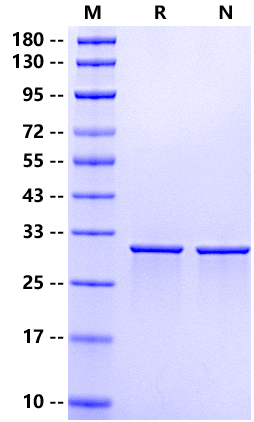Product Details
Product Details
Product Specification
| Species | Mouse |
| Synonyms | FGF-8c, rMuFGF-8c, AIGF, HBGF-8 |
| Accession | P37237 |
| Amino Acid Sequence | Gln23-Arg268 |
| Expression System | E.coli |
| Molecular Weight | 28-29kDa |
| Purity | >95% by SDS-PAGE |
| Endotoxin | <1EU/μg |
| Conjugation | Unconjugated |
| Tag | No Tag |
| Physical Appearance | Lyophilized Powder |
| Storage Buffer | 20mM Tris, 100mM NaCl, pH8.0 |
| Reconstitution | Reconstitute at 0.1-1 mg/ml according to the size in ultrapure water after rapid centrifugation. |
| Stability & Storage |
12 months from date of receipt, -20 to -70 °C as supplied; 6 months, -20 to -70 °C under sterile conditions after reconstitution; 1 week, 2 to 8 °C under sterile conditions after reconstitution; Please avoid repeated freeze-thaw cycles. |
Background
Fibroblast Growth Factor 8 was originally identified as an androgen-dependent growth of mouse mammary carcinoma cells. The primary transcript of mouse FGF-8 is alternatively spliced to generate at least 8 secreted isoforms that differ at their amino terminus. The differences between the isoforms exist in the number of potential N-linked glycosylation sites. In mouse, the eight isoforms are labeled as 8a through 8h. Human FGF-8 is limited to only four isoforms. Only isoforms 8a, 8b, 8e, and 8f are synthesized in humans. Mouse and human 8a and 8b isoforms are 100% identical, while the 8e and 8f isoforms are 98% identical. The FGF-8 isoforms differentially activate the various alternatively spliced forms of the FGF receptors 1-3, and FGF receptor 4. The isoform FGF-8c activates FGF R3c and FGF R4.
Picture
Picture
SDS-PAGE



